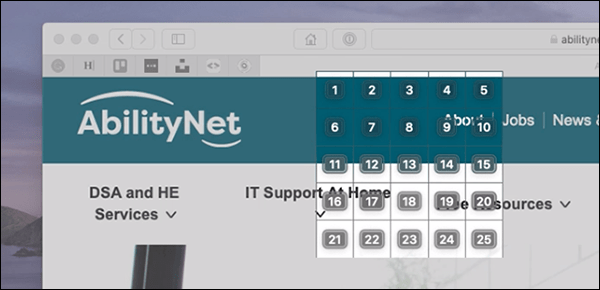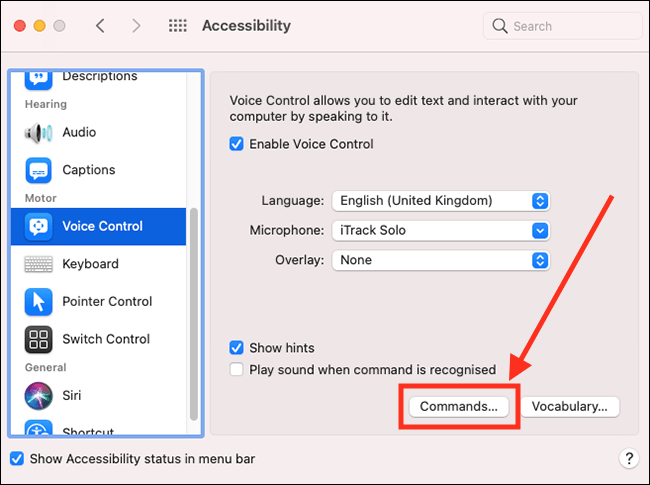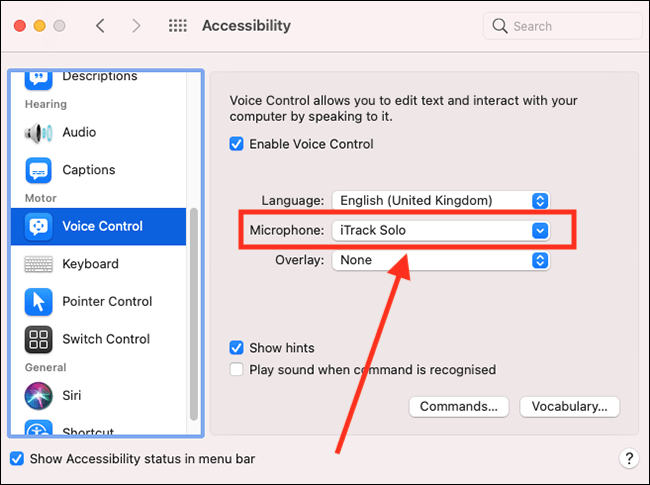In this article
How to enable Voice Control
How to use Voice Control to control your computer
Voice Control commands
How to use Number Overlays
How to use Grid Overlays
How to use Dictation
How to create your own Voice Control commands
Voice Control settings
How to enable Voice Control
- Select the Apple icon
 in the top left corner of the screen.
in the top left corner of the screen. - Select System Preferences from the menu.

- On the System Preferences window, select the Accessibility icon.

- On the Accessibility screen, scroll down the left-column and select Voice Control.

- In the right column, tick the checkbox for Enable Voice Control.

- Your computer will now download the Voice Control software if it isn’t already installed.
- When you have finished, click the Close (red) button in the top left corner of the System Preferences window.
How to use Voice Control to control your computer
- When Voice Control is on, a floating microphone button will appear on screen.

- When you speak a command, the command will be shown above the microphone button.

- If you would like to pause Voice Control so that your computer stops listening for commands, say “Go to sleep” or select Sleep on the button. To resume Voice Control, say “Wake up” or select Wake on the button.

Voice Control commands
- You can control your computer by speaking commands such as
- Open {app name}
- Close {app name}
- Hide {app name}
- Scroll up/down Open {document name}
- Save document
- Zoom in/out
- Turn volume up/down
- Single/Double/Triple click
- Select {word}
- Select {phrase}
- Search for {phrase}
- Click {name of toolbar menu}
Tip: To see the full list of commands that you can use with Voice Control, say “Show Commands”.

- You can create your own voice commands. See the How to create your own Voice Control commands section, below, for more information.
How to use Number Overlays
Number Overlays let you interact with what is on screen by showing numbers next to clickable items, such a menus, buttons, and links.
- To show number overlays, say “Show numbers”.
- Then say “Click {number}” to select that item.

Note: Numbers will appear next to the items in system menus without first having to saying the “Show numbers” command. For instance, say "Click File", then choose a number from the File menu.

How to use Grid Overlays
Use Grid Overlays to intersect with areas of the screen that Voice Control doesn’t recognise as being clickable.
- To show a numbered grid, say “Show grid” or “Show window grid” to limit the grid to the active window.

- Say a grid number to subdivide that grid square. Repeat as many times as necessary to define your selection.

- To select the area behind a grid number, say “Click {number}” or “Zoom {number}” to zoom in on that area of the grid.
- You can also use grids to drag an item from one area to another – select an item, then say “Drag x to y”.
How to use Dictation
When you have selected an area where you can enter text, you can immediately start dictating what you would like to write. You can use commands to select the text and edit it. For instance, you can say “Select {word or phrase}”, then “Bold that”.
How to create your own Voice Control commands
You can create your own commands to use with Voice Control.
- Open voice control preferences by saying “Open Voice Control preferences”
- Select the Command button or say, “Click Commands”.

- On the next screen, select the + (add) button or say, “Click add”.

- Then configure the options:
- When I say – Enter, or speak, the phrase you would like to use as the new command.
- While using – Use the new command with any application or choose a specific application to use it with.
- Perform – Choose the action to perform when using the new command.

- When you have finished adding new commands, select the Done button or say “Click Done”.

- When you have finished, select the Close (red) button in the top left corner of the System Preferences window.
Voice Control Settings
- Select the Apple icon
 in the top left corner of the screen.
in the top left corner of the screen. - Select System Preferences from the menu.

- On the System Preferences window, select the Accessibility icon.

- On the Accessibility screen, scroll down the left-column and select Voice Control.

- In the right column, you can now customise the following settings:
Language
Voice Control uses the language you selected when you set-up your computer. To change this, select Language and choose from the options.

Microphone
If you have more than one microphone attached to your device, choose the one you would like to use from the drop-down list for Microphone.

Overlay
To make navigating your device easier, you can ask Voice control to overlay numbers next to the items on the screen or display a grid with reference numbers. You then speak a number to select the corresponding item or a grid square. See the How to use Number Overlays and How to use Grid Overlays sections for more information.
If you'd prefer to always show one of the overlays on the screen, select the drop-down menu for Overlays and choose your preferred option.

Show hints
When you say something that is similar to a voice command, for example, “Start Finder”, Voice Control briefly displays suggested commands you could try using instead.

An example of hints
Suggested hints are only displayed if the checkbox for Show hints is ticked.

Play a sound when a command is recognised
If you would like to hear a sound to confirm that Voice Control has recognised a command, tick the checkbox for Play sound when command is recognised.

When you have finished, click the Close (red) button in the top left corner of the System Preferences window.
Note: If this does not work, it could be because someone else manages your computer settings (an IT department or administrator). If this is the case, you will need to contact them to access these settings or for further help.